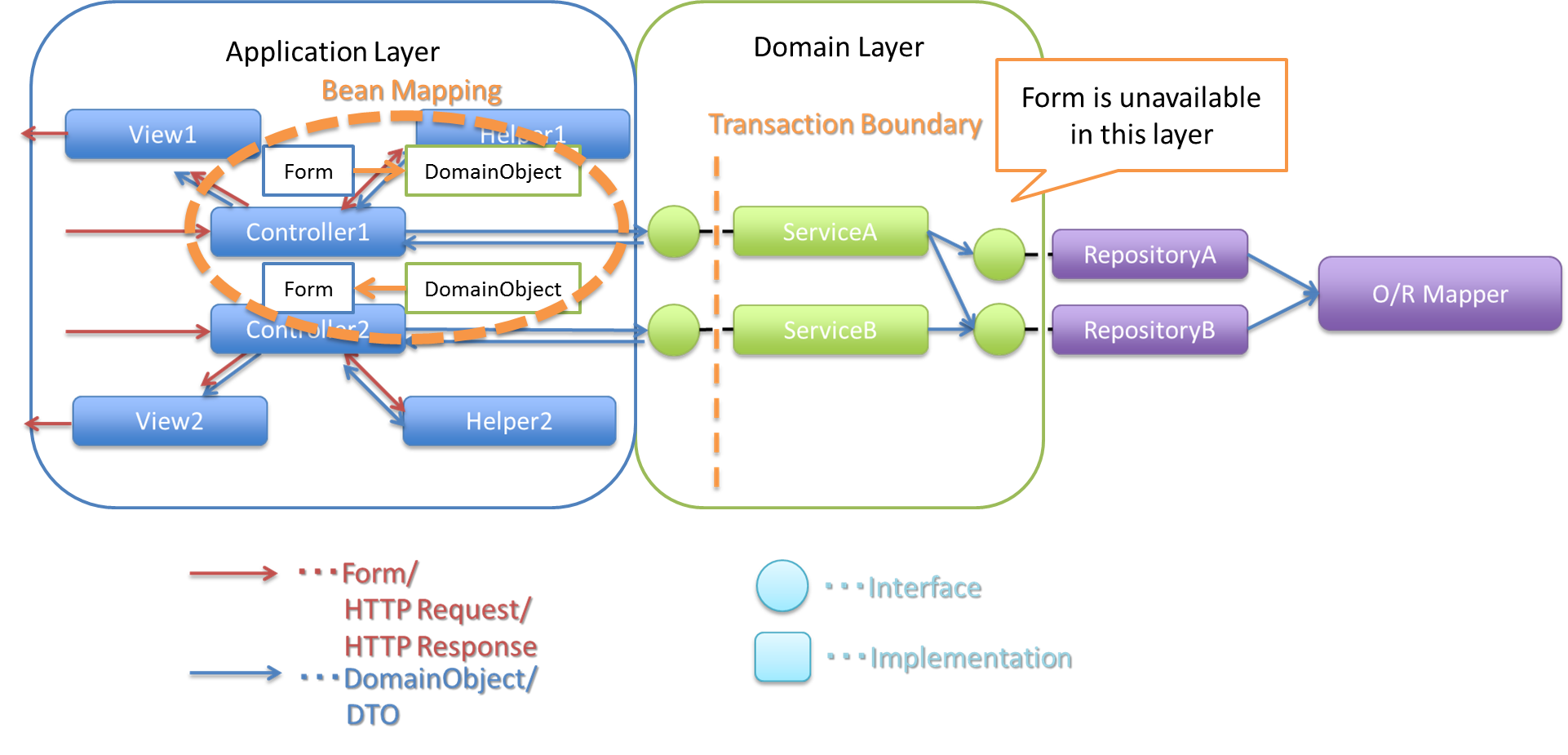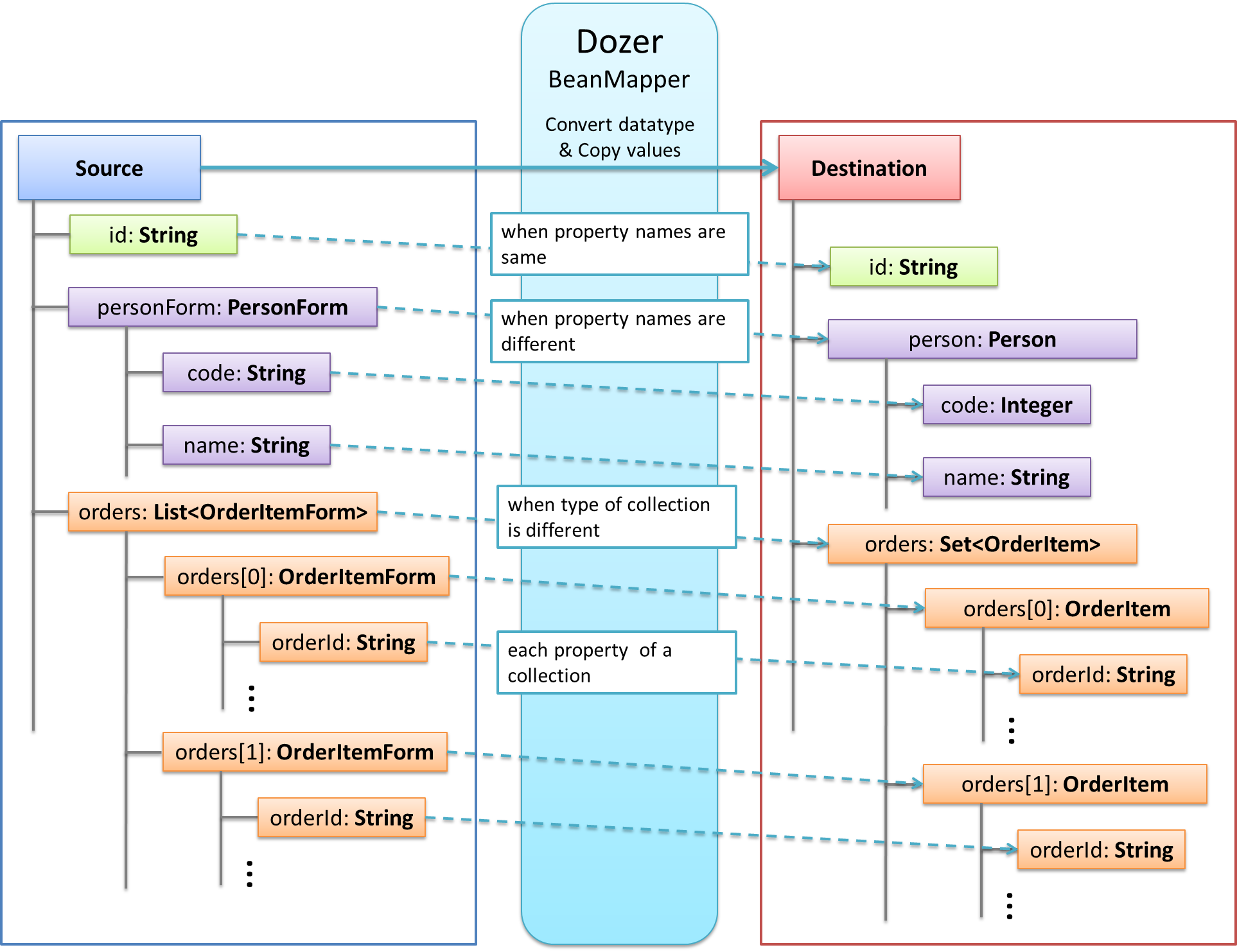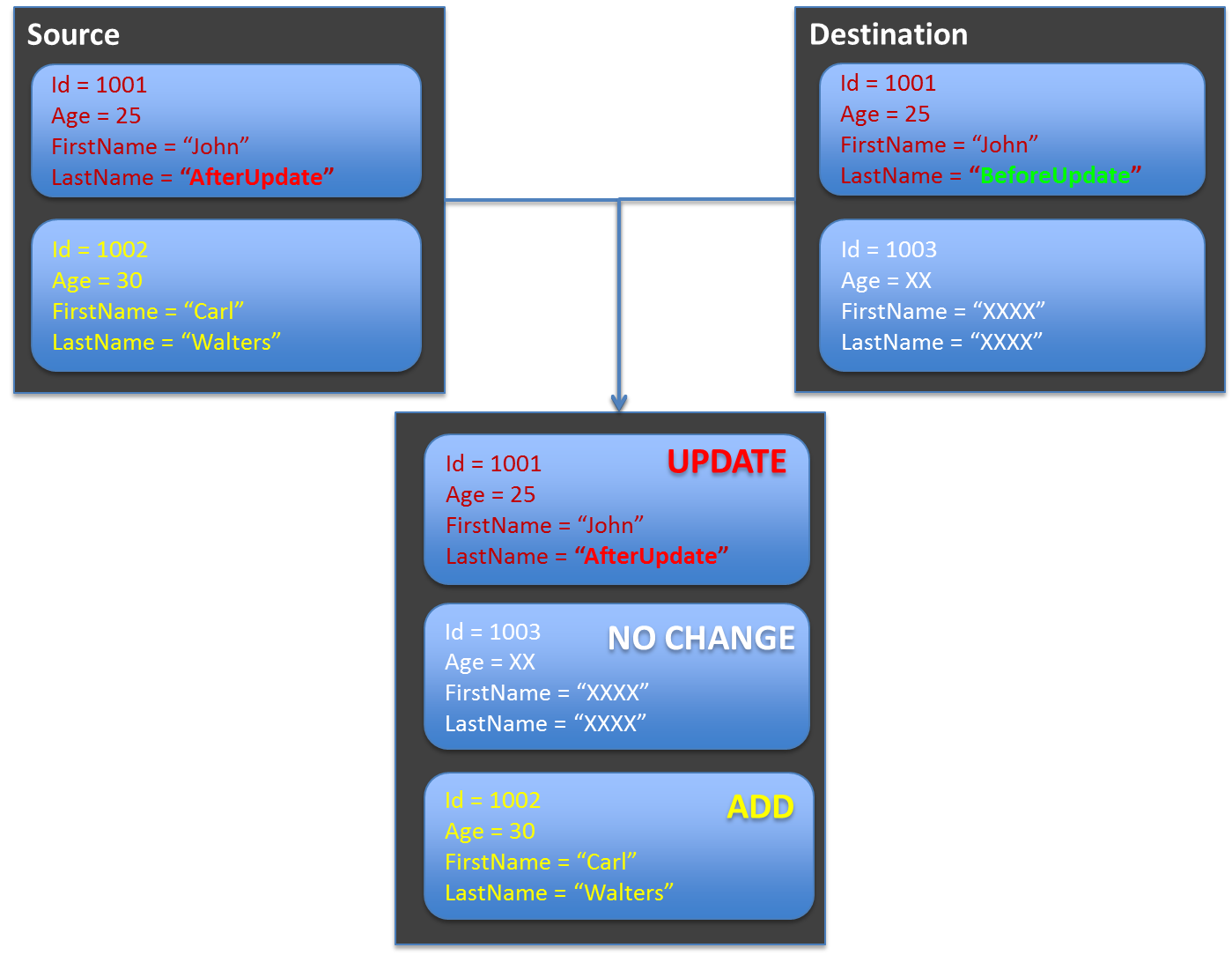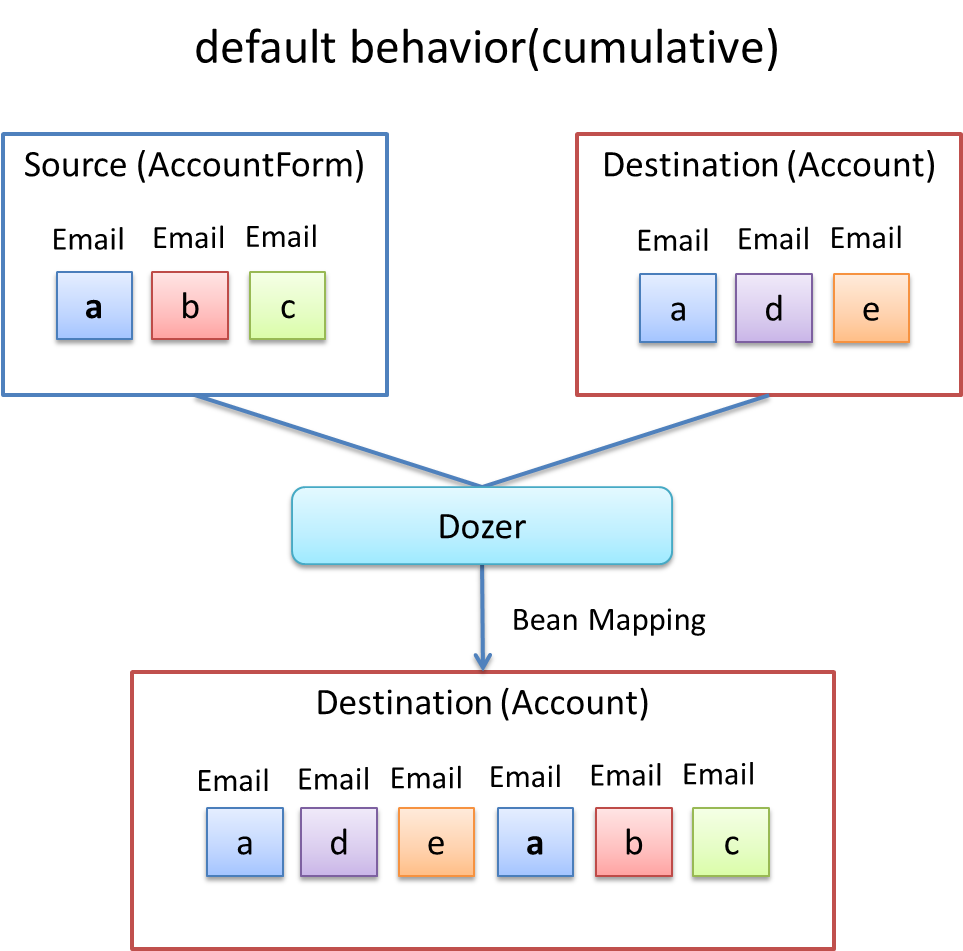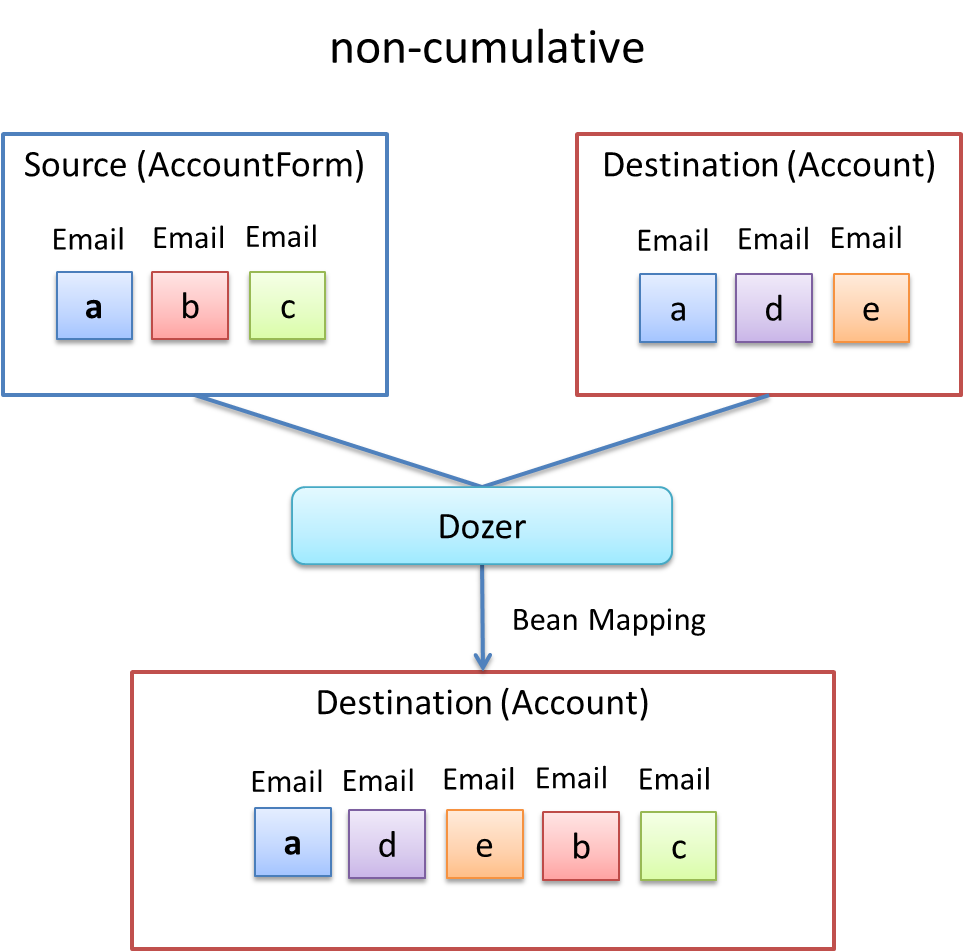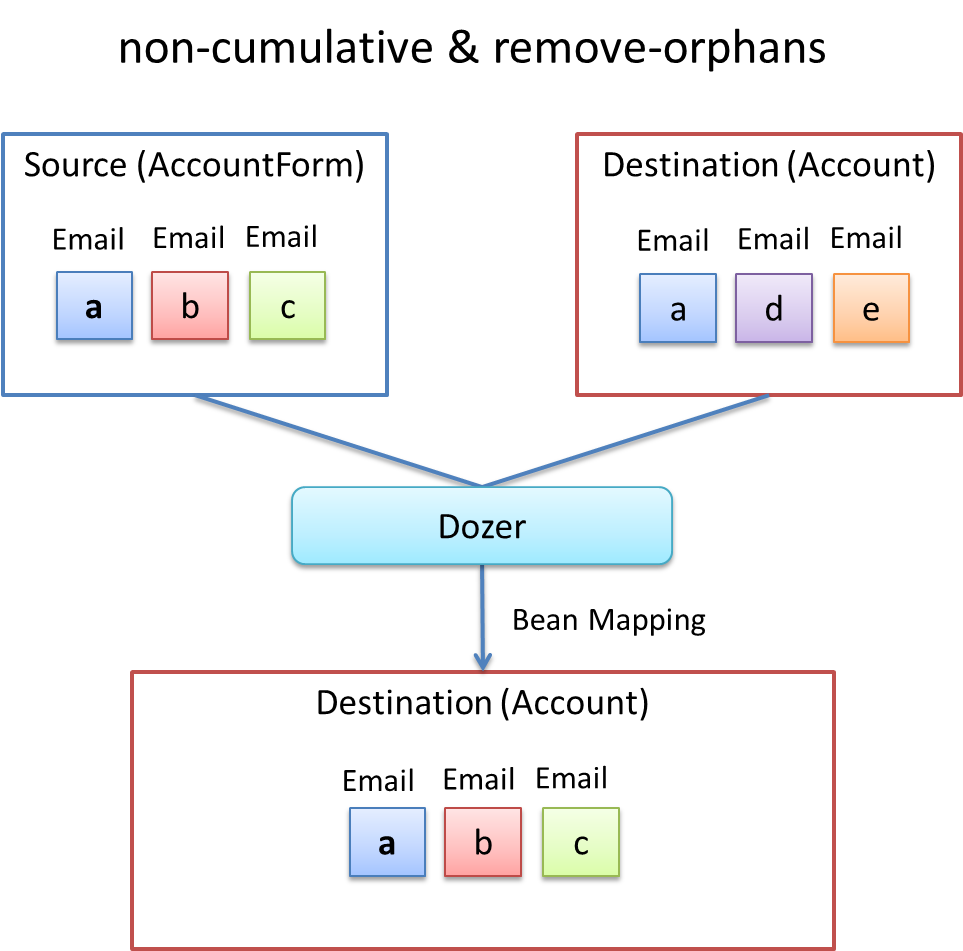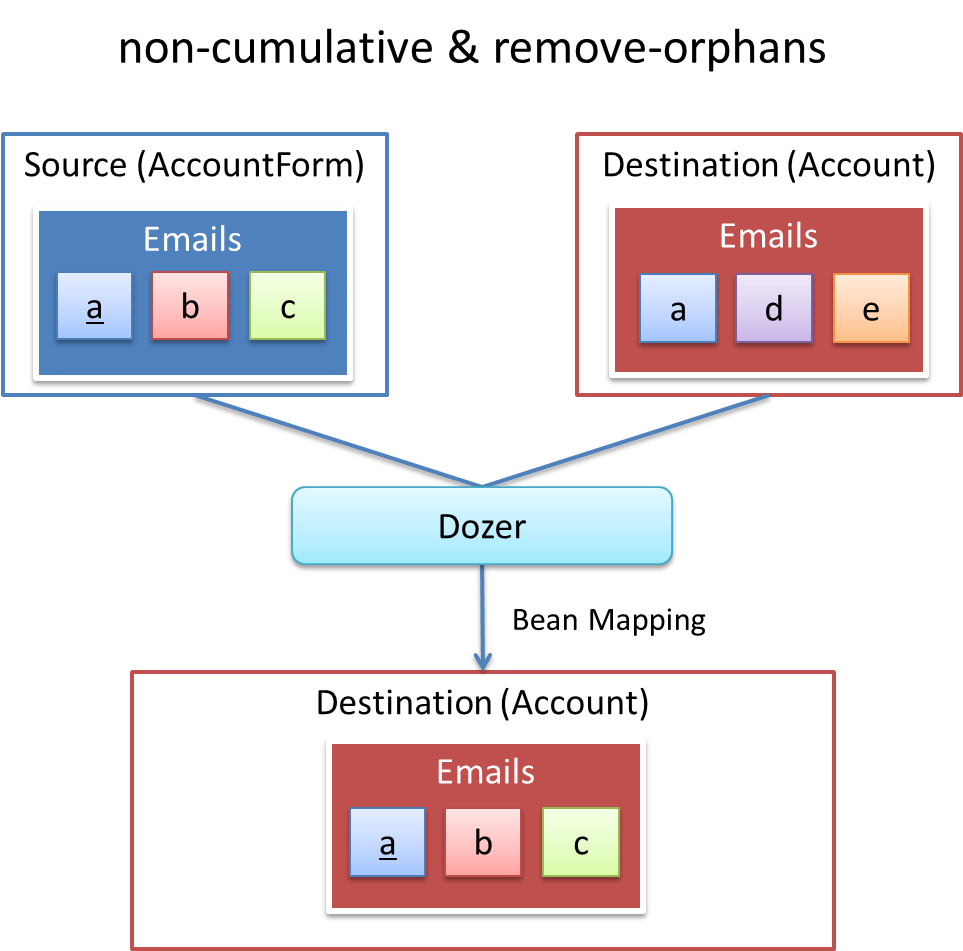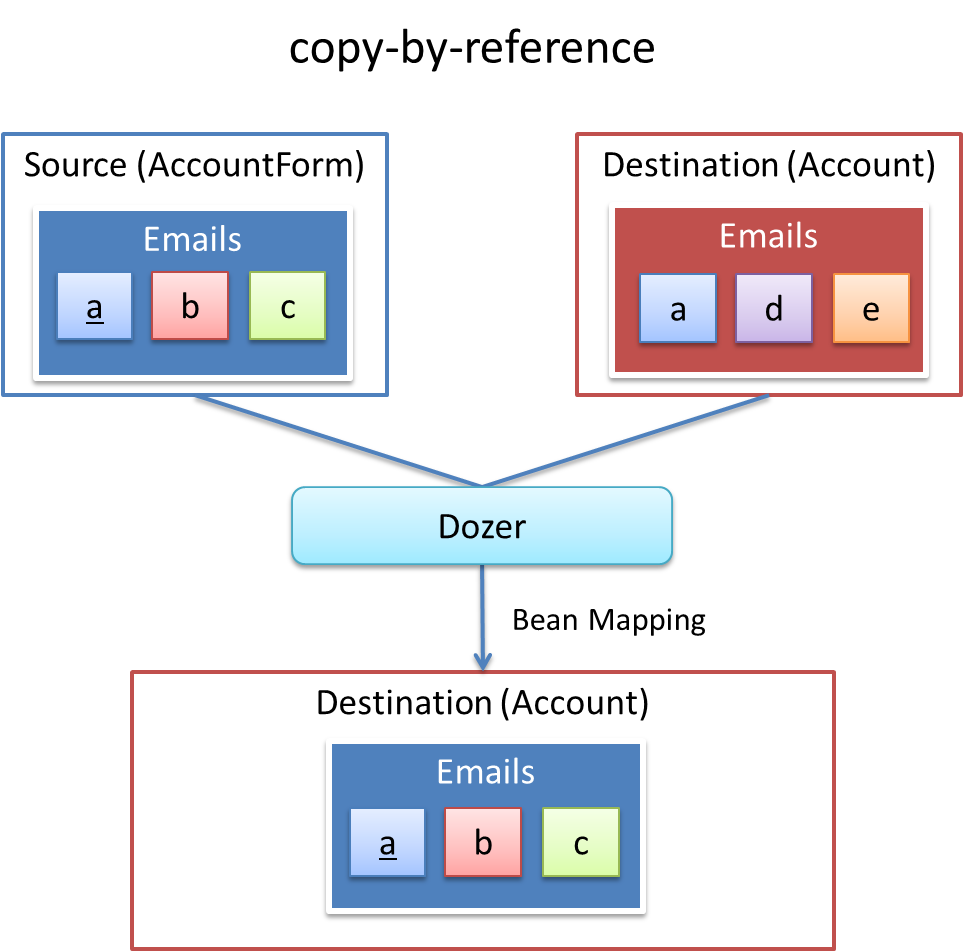5.21.1. Beanマッピング(Dozer)¶
5.21.1.1. Overview¶
Beanマッピングは、一つのBeanを他のBeanにフィールド値をコピーすることである。
AccountFormオブジェクトを、ドメイン層のAccountオブジェクトに変換する場合を考える。AccountFormオブジェクトを、AccountオブジェクトにBeanマッピングし、ドメイン層では、Accountオブジェクトを使用する。Dozerをした場合と使用しない場合のコード例を挙げる。
煩雑になり、プログラムの見通しが悪くなる例
User user = userService.findById(userId); XxxOutput output = new XxxOutput(); output.setUserId(user.getUserId()); output.setFirstName(user.getFirstName()); output.setLastName(user.getLastName()); output.setTitle(user.getTitle()); output.setBirthDay(user.getBirthDay()); output.setGender(user.getGender()); output.setStatus(user.getStatus());
Dozerを使用した場合の例
User user = userService.findById(userId); XxxOutput output = beanMapper.map(user, XxxOutput.class);
以降は、Dozerの利用方法について説明する。
5.21.1.2. How to use¶
Dozerは、Java Beanのマッピング機能ライブラリである。 変換元のBeanから変換先のBeanに、再帰的(ネストした構造)に、値をコピーする。
5.21.1.2.1. Dozerを使用するためのBean定義¶
Dozerは、単独で使用するとき、以下のように、 org.dozer.Mapper のインスタンスを作成する。
Mapper mapper = new DozerBeanMapper();
Mapper のインスタンスを毎回作成するのは、効率が悪いため、
Dozerが提供している org.dozer.spring.DozerBeanMapperFactoryBean を使用すること。
Bean定義ファイル(applicationContext.xml)に、Mapperを作成するFactoryクラスであるorg.dozer.spring.DozerBeanMapperFactoryBeanを定義する
<bean class="org.dozer.spring.DozerBeanMapperFactoryBean">
<property name="mappingFiles"
value="classpath*:/META-INF/dozer/**/*-mapping.xml" /><!-- (1) -->
</bean>
| 項番 | 説明 |
|---|---|
(1)
|
mappingFilesに、マッピング定義XMLファイルを指定する。
org.dozer.spring.DozerBeanMapperFactoryBean は、 interfaceとして org.dozer.Mapper を保持している。そのため、 @Inject 時は Mapper を指定する。この例では、クラスパス直下の、/META-INF/dozerの任意フォルダ内の
(任意の値)-mapping.xmlを、すべて読み込む。このXMLファイルの内容については、以降で説明する。
|
Beanマッピングを行いたいクラスに、 Mapper をインジェクトすればよい。
@Inject
Mapper beanMapper;
5.21.1.2.2. Bean間のフィールド名、型が同じ場合のマッピング¶
デフォルトの動作として、Dozerは対象のBean間のフィールド名が同じであれば、マッピング定義XMLファイルを作成せずにマッピングできる。
変換元のBean定義
public class Source {
private int id;
private String name;
// ommited setter/getter
}
変換先のBean定義
public class Destination {
private int id;
private String name;
// ommited setter/getter
}
以下のように、 Mapper の map メソッドを使ってBeanマッピングを行う。
下記メソッドを実行した後、Destinationオブジェクトが新たに作成され、sourceの各フィールドの値が作成されたDestinationオブジェクトにコピーされる。
Source source = new Source();
source.setId(1);
source.setName("SourceName");
Destination destination = beanMapper.map(source, Destination.class); // (1)
System.out.println(destination.getId());
System.out.println(destination.getName());
| 項番 | 説明 |
|---|---|
(1)
|
第一引数に、コピー元のオブジェクトを渡し、第二引数に、コピー先のBeanのクラスを渡す。
|
上記のコードを実行すると以下のように出力される。作成されたオブジェクトにコピー元のオブジェクトの値が設定されていることが分かる。
1
SourceName
既に存在しているdestinationオブジェクトに、sourceオブジェクトのフィールドをコピーしたい場合は、
Source source = new Source();
source.setId(1);
source.setName("SourceName");
Destination destination = new Destination();
destination.setId(2);
destination.setName("DestinationName");
beanMapper.map(source, destination); // (1)
System.out.println(destination.getId());
System.out.println(destination.getName());
| 項番 | 説明 |
|---|---|
(1)
|
第一引数に、コピー元のオブジェクトを渡し、第二引数に、コピー先のオブジェクトを渡す。
|
上記のコードを実行すると以下のように出力される。コピー元のオブジェクトの値がコピー先に反映されていることが分かる。
1
SourceName
Note
DestinationクラスのフィールドでSourceクラスに存在しないものは、コピー前後で値は変わらない。
変換元のBean定義
public class Source { private int id; private String name; // ommited setter/getter }
変換先のBean定義
public class Destination { private int id; private String name; private String title; // ommited setter/getter }
マッピング例
Source source = new Source(); source.setId(1); source.setName("SourceName"); Destination destination = new Destination(); destination.setId(2); destination.setName("DestinationName"); destination.setTitle("DestinationTitle"); beanMapper.map(source, destination); System.out.println(destination.getId()); System.out.println(destination.getName()); System.out.println(destination.getTitle());
上記のコードを実行すると以下のように出力される。Sourceクラスにはtitleフィールドが
ないため、Destinationオブジェクトのtitleフィールドは、コピー前のフィールド値から変更がない。
1 SourceName DestinationTitle
5.21.1.2.3. Bean間のフィールド名は同じ、型が異なる場合のマッピング¶
コピー元と、コピー先でBeanのフィールドの型が異なる場合、 型変換がサポートされている型は、自動でマッピングできる。
以下のような変換は、マッピング定義XMLファイル無しで変換できる。
例 : String -> BigDecimal
変換元のBean定義
public class Source {
private String amount;
// ommited setter/getter
}
変換先のBean定義
public class Destination {
private BigDecimal amount;
// ommited setter/getter
}
マッピング例
Source source = new Source();
source.setAmount("123.45");
Destination destination = beanMapper.map(source, Destination.class);
System.out.println(destination.getAmount());
上記のコードを実行すると以下のように出力される。型が異なる場合でも値をコピーできていることが分かる。
123.45
サポートされている型変換については、 マニュアル を参照されたい。
5.21.1.2.4. Bean間のフィールド名が異なる場合のマッピング¶
コピー元と、コピー先でフィールド名が異なる場合、マッピング定義XMLファイルを作成し、 Beanマッピングするフィールドを定義することで変換できる。
変換元のBean定義
public class Source {
private int id;
private String name;
// ommited setter/getter
}
変換先のBean定義
public class Destination {
private int destinationId;
private String destinationName;
// ommited setter/getter
}
Dozerを使用するためのBean定義の定義がある場合、 src/main/resources/META-INF/dozerフォルダ内に、(任意の値)-mapping.xmlという、マッピング定義XMLファイルを作成する。
<?xml version="1.0" encoding="UTF-8"?>
<mappings xmlns="http://dozer.sourceforge.net" xmlns:xsi="http://www.w3.org/2001/XMLSchema-instance"
xsi:schemaLocation="http://dozer.sourceforge.net
http://dozer.sourceforge.net/schema/beanmapping.xsd">
<mapping>
<class-a>com.xx.xx.Source</class-a><!-- (1) -->
<class-b>com.xx.xx.Destination</class-b><!-- (2) -->
<field>
<a>id</a><!-- (3) -->
<b>destinationId</b><!-- (4) -->
</field>
<field>
<a>name</a>
<b>destinationName</b>
</field>
</mapping>
</mappings>
| 項番 | 説明 |
|---|---|
(1)
|
<class-a>タグ内にコピー元のBeanの、完全修飾クラス名(FQCN)を指定する。 |
(2)
|
<class-b>タグ内にコピー先のBeanの、完全修飾クラス名(FQCN)を指定する。 |
(3)
|
<field>タグ内の<a>タグ内にコピー元のBeanの、マッピング用のフィールド名を指定する。 |
(4)
|
<field>タグ内の<b>タグ内に(3)に対応するコピー先のBeanの、マッピング用のフィールド名を指定する。 |
マッピング例
Source source = new Source();
source.setId(1);
source.setName("SourceName");
Destination destination = beanMapper.map(source, Destination.class); // (1)
System.out.println(destination.getDestinationId());
System.out.println(destination.getDestinationName());
| 項番 | 説明 |
|---|---|
(1)
|
第一引数に、コピー元のオブジェクトを渡し、第二引数に、コピー先のBeanのクラスを渡す。(基本マッピングと違いはない。)
|
上記のコードを実行すると以下のように出力される。
1
SourceName
Dozerを使用するためのBean定義の設定によって、mappingFilesプロパティにクラスパス直下のMETA-INF/dozer配下に存在するマッピング定義XMLファイルが読み込まれる。
ファイル名は(任意の値)-mapping.xmlである必要がある。
いずれかのファイル内にSourceクラスとDestinationクラス間におけるマッピング定義があれば、その設定が適用される。
Note
マッピング定義XMLファイルは、Controller単位で作成し、ファイル名は、(Controller名からControllerを除いた値)-mapping.xmlにすることを推奨する。 例えば、TodoControllerに対するマッピング定義XMLファイルは、src/main/resources/META-INF/dozer/todo-mapping.xmlに作成する。
5.21.1.2.5. 単方向・双方向マッピング¶
マッピングXMLで定義されているマッピングは、デフォルトで、双方向マッピングである。
すなわち前述の例ではSourceオブジェクトからDestinationオブジェクトへのマッピングを行ったが、
DestinationオブジェクトからSourceオブジェクトのマッピングも可能である。
単方向をのみを指定したい場合は、マッピング・フィールド定義に、<mapping>タグのtype属性に"one-way"を設定する。
<?xml version="1.0" encoding="UTF-8"?>
<mappings xmlns="http://dozer.sourceforge.net" xmlns:xsi="http://www.w3.org/2001/XMLSchema-instance"
xsi:schemaLocation="http://dozer.sourceforge.net
http://dozer.sourceforge.net/schema/beanmapping.xsd">
<!-- omitted -->
<mapping type="one-way">
<class-a>com.xx.xx.Source</class-a>
<class-b>com.xx.xx.Destination</class-b>
<field>
<a>id</a>
<b>destinationId</b>
</field>
<field>
<a>name</a>
<b>destinationName</b>
</field>
</mapping>
<!-- omitted -->
</mappings>
変換元のBean定義
public class Source {
private int id;
private String name;
// ommited setter/getter
}
変換先のBean定義
public class Destination {
private int destinationId;
private String destinationName;
// ommited setter/getter
}
マッピング例
Source source = new Source();
source.setId(1);
source.setName("SourceName");
Destination destination = beanMapper.map(source, Destination.class);
System.out.println(destination.getDestinationId());
System.out.println(destination.getDestinationName());
上記のコードを実行すると以下のように出力される。
1
SourceName
単方向を指定している場合に、逆方向のマッピングを行ってもエラーは発生しない。コピー処理は無視される。
なぜなら、マッピング定義がないとDestinationのフィールドに該当するSourceのフィールドが存在ないとみなされるためである。
Destination destination = new Destination();
destination.setDestinationId(2);
destination.setDestinationName("DestinationName");
Source source = new Source();
source.setId(1);
source.setName("SourceName");
beanMapper.map(destination, source);
System.out.println(source.getId());
System.out.println(source.getName());
上記のコードを実行すると以下のように出力される。
1
SourceName
5.21.1.2.6. Nestしたフィールドのマッピング¶
コピー元Beanが持つフィールドを、コピー先Beanが持つNestしたBeanのフィールドにも、マッピングできることである。 (Dozerの用語で、 Deep Mapping と呼ばれる。)
変換元のBean定義
public class EmployeeForm {
private int id;
private String name;
private String deptId;
// omitted setter/getter
}
変換先のBean定義
public class Employee {
private Integer id;
private String name;
private Department department;
// omitted setter/getter
}
public class Department {
private String deptId;
// omitted setter/getter and other fields
}
例 : EmployeeFormオブジェクトが持つdeptIdを、Employeeオブジェクトが持つDepartmentのdeptIdにマップしたい場合、
以下のように定義する。
<?xml version="1.0" encoding="UTF-8"?>
<mappings xmlns="http://dozer.sourceforge.net" xmlns:xsi="http://www.w3.org/2001/XMLSchema-instance"
xsi:schemaLocation="http://dozer.sourceforge.net
http://dozer.sourceforge.net/schema/beanmapping.xsd">
<!-- omitted -->
<mapping map-empty-string="false" map-null="false">
<class-a>com.xx.aa.EmployeeForm</class-a>
<class-b>com.xx.bb.Employee</class-b>
<field>
<a>deptId</a>
<b>department.deptId</b><!-- (1) -->
</field>
</mapping>
<!-- omitted -->
</mappings>
| 項番 | 説明 |
|---|---|
(1)
|
EmployeeフォームのdeptIdに対する、Employeeオブジェクトのフィールドを指定する。 |
マッピング例
EmployeeForm source = new EmployeeForm();
source.setId(1);
source.setName("John");
source.setDeptId("D01");
Employee destination = beanMapper.map(source, Employee.class);
System.out.println(destination.getId());
System.out.println(destination.getName());
System.out.println(destination.getDepartment().getDeptId());
上記のコードを実行すると以下のように出力される。
1
John
D01
上記の場合は、変換先クラスであるEmployeeの新規インスタンスが作成される。
Employeeの中のdepartment フィールドにも、新規に作成されたDepartmentインスタンスが設定され、
EmployeeFormのdeptIdが、コピーされる。
下記ようにEmployeeの中のdepartment フィールドに既にDepartmentオブジェクトが設定されている場合は、
新規インスタンスは作成されず、既存のDepartmentオブジェクトのdeptIdフィールドに、
EmployeeFormのdeptIdがコピーされる。
EmployeeForm source = new EmployeeForm();
source.setId(1);
source.setName("John");
source.setDeptId("D01");
Employee destination = new Employee();
Department department = new Department();
destination.setDepartment(department);
beanMapper.map(source, destination);
System.out.println(department.getDeptId());
System.out.println(destination.getDepartment() == department);
上記のコードを実行すると以下のように出力される。
D01
true
5.21.1.2.7. Collectionマッピング¶
Dozerは、以下のCollectionタイプの双方向自動マッピングをサポートしている。 フィールド名が同じである場合、マッピング定義XMLファイルが不要である。
java.util.List<=>java.util.Listjava.util.List<=> Array- Array <=> Array
java.util.Set<=>java.util.Setjava.util.Set<=> Arrayjava.util.Set<=>java.util.List
次のクラスのコレクションをもつBeanのマッピングについて考える。
package com.example.dozer;
public class Email {
private String email;
public Email() {
}
public Email(String email) {
this.email = email;
}
public String getEmail() {
return email;
}
public void setEmail(String email) {
this.email = email;
}
@Override
public String toString() {
return email;
}
// generated by Eclipse
@Override
public int hashCode() {
final int prime = 31;
int result = 1;
result = prime * result + ((email == null) ? 0 : email.hashCode());
return result;
}
// generated by Eclipse
@Override
public boolean equals(Object obj) {
if (this == obj)
return true;
if (obj == null)
return false;
if (getClass() != obj.getClass())
return false;
Email other = (Email) obj;
if (email == null) {
if (other.email != null)
return false;
} else if (!email.equals(other.email))
return false;
return true;
}
}
変換元のBean
package com.example.dozer;
import java.util.List;
public class AccountForm {
private List<Email> emails;
public void setEmails(List<Email> emails) {
this.emails = emails;
}
public List<Email> getEmails() {
return emails;
}
}
変換先のBean
package com.example.dozer;
import java.util.List;
public class Account {
private List<Email> emails;
public void setEmails(List<Email> emails) {
this.emails = emails;
}
public List<Email> getEmails() {
return emails;
}
}
マッピング例
AccountForm accountForm = new AccountForm();
List<Email> emailsSrc = new ArrayList<Email>();
emailsSrc.add(new Email("a@example.com"));
emailsSrc.add(new Email("b@example.com"));
emailsSrc.add(new Email("c@example.com"));
accountForm.setEmails(emailsSrc);
Account account = beanMapper.map(accountForm, Account.class);
System.out.println(account.getEmails());
上記のコードを実行すると以下のように出力される。
[a@example.com, b@example.com, c@example.com]
ここまではこれまで説明したことと特に変わりはない。
次の例のように、コピー先のBeanのCollectionフィールドに既に要素が追加されている場合は要注意である。
AccountForm accountForm = new AccountForm();
Account account = new Account();
List<Email> emailsSrc = new ArrayList<Email>();
List<Email> emailsDest = new ArrayList<Email>();
emailsSrc.add(new Email("a@example.com"));
emailsSrc.add(new Email("b@example.com"));
emailsSrc.add(new Email("c@example.com"));
emailsDest.add(new Email("a@example.com"));
emailsDest.add(new Email("d@example.com"));
emailsDest.add(new Email("e@example.com"));
accountForm.setEmails(emailsSrc);
account.setEmails(emailsDest);
beanMapper.map(accountForm, account);
System.out.println(account.getEmails());
上記のコードを実行すると以下のように出力される。
[a@example.com, d@example.com, e@example.com, a@example.com, b@example.com, c@example.com]
コピー元BeanのCollectionの全要素が、コピー先BeanのCollectionに追加されている。
a@exmample.comをもつ2つのEmailオブジェクトは”等価”であるが、単純に追加される。
(ここでいう”等価”とはEmail.equals で比較するとtrueになり、Email.hashCodeの値も同じであることを意味する。)
上記の振る舞いは、Dozerの用語ではcumulativeと呼ばれ、Collectionをマッピングする際のデフォルトの挙動となっている。
この挙動はマッピング定義XMLファイルにおいて変更することができる。
<?xml version="1.0" encoding="UTF-8"?>
<mappings xmlns="http://dozer.sourceforge.net" xmlns:xsi="http://www.w3.org/2001/XMLSchema-instance"
xsi:schemaLocation="http://dozer.sourceforge.net
http://dozer.sourceforge.net/schema/beanmapping.xsd">
<!-- omitted -->
<mapping>
<class-a>com.example.dozer.AccountForm</class-a>
<class-b>com.example.dozer.Account</class-b>
<field relationship-type="non-cumulative"><!-- (1) -->
<a>emails</a>
<b>emails</b>
</field>
</mapping>
<!-- omitted -->
</mappings>
| 項番 | 説明 |
|---|---|
(1)
|
<field>タグのrelationship-type属性にnon-cumulativeを指定する。デフォルト値はcumulativeである。マッピング対象のBeanの全フィールドに対して
non-cumulativeを指定したい場合は、<mapping>タグのrelationship-type属性にnon-cumulativeを指定することもできる。 |
この設定のもと、前述のコードを実行すると以下のように出力される。
[a@example.com, d@example.com, e@example.com, b@example.com, c@example.com]
等価であるオブジェクトの重複がなくなっていることが分かる。
コピー先のコレクションにのみに存在する項目は除外したい場合も、マッピング定義XMLファイルの設定で実現することができる。
<?xml version="1.0" encoding="UTF-8"?>
<mappings xmlns="http://dozer.sourceforge.net" xmlns:xsi="http://www.w3.org/2001/XMLSchema-instance"
xsi:schemaLocation="http://dozer.sourceforge.net
http://dozer.sourceforge.net/schema/beanmapping.xsd">
<!-- omitted -->
<mapping>
<class-a>com.example.dozer.AccountForm</class-a>
<class-b>com.example.dozer.Account</class-b>
<field relationship-type="non-cumulative" remove-orphans="true" ><!-- (1) -->
<a>emails</a>
<b>emails</b>
</field>
</mapping>
<!-- omitted -->
</mappings>
| 項番 | 説明 |
|---|---|
(1)
|
<field>タグのremove-orphans属性にtrueを設定する。デフォルト値はfalseである。 |
この設定のもと、前述のコードを実行すると以下のように出力される。
[a@example.com, b@example.com, c@example.com]
コピー元にあるオブジェクトだけがコピー先のコレクション内に残っていることが分かる。
いかのように設定しても同じ結果が得られる。
<?xml version="1.0" encoding="UTF-8"?>
<mappings xmlns="http://dozer.sourceforge.net" xmlns:xsi="http://www.w3.org/2001/XMLSchema-instance"
xsi:schemaLocation="http://dozer.sourceforge.net
http://dozer.sourceforge.net/schema/beanmapping.xsd">
<!-- omitted -->
<mapping>
<class-a>com.example.dozer.AccountForm</class-a>
<class-b>com.example.dozer.Account</class-b>
<field copy-by-reference="true"><!-- (1) -->
<a>emails</a>
<b>emails</b>
</field>
</mapping>
<!-- omitted -->
</mappings>
| 項番 | 説明 |
|---|---|
(1)
|
<field>タグのcopy-by-reference属性にtrueを設定する。デフォルト値はfalseである。 |
これまでの挙動を図で表現する。
デフォルトの挙動(cumulative)
non-cumulative
non-cumulativeかつremove-orphans=true
Note
「non-cumulativeかつremove-orphans=true」のパターンと「copy-by-reference」のパターンの違いは、Bean変換後のCollectionのコンテナがコピー先のものか、コピー元のものかで異なる点である。
「non-cumulativeかつremove-orphans=true」のパターンの場合は、Bean変換後のCollectionのコンテナはコピー先のものであり、「copy-by-reference」のパターンはコピー元のものである。 以下に図で説明する。
non-cumulativeかつremove-orphans=true
copy-by-reference
コピー先がJPA (Hibernate)のエンティティで1対多や多対多の関連を持つ場合は要注意である。コピー先のエンティティがEntityManagerの管理下にある場合、予期せぬトラブルに遭うことがある。 例えばコレクションのコンテナが変更されると全件DELETE + 全件INSERTのSQLが発行され、「non-cumulativeかつremove-orphans=true」でコピーした場合は変更内容をUPDATE(要素数が異なる場合はDELETE or INSERT)のSQLが発行される場合がある。 どちらが良いかは要件次第である。
Warning
マッピング対象のBeanがStringのコレクションを持つ場合、期待通りの挙動にならないバグがある。
StringListSrc src = new StringListSrc; StringListDest dest = new StringListDest(); List<String> stringsSrc = new ArrayList<String>(); List<String> stringsDest = new ArrayList<String>(); stringsSrc.add("a"); stringsSrc.add("b"); stringsSrc.add("c"); stringsDest.add("a"); stringsDest.add("d"); stringsDest.add("e"); src.setStrings(stringsSrc); dest.setStrings(stringsDest); beanMapper.map(src, dest); System.out.println(dest.getStrings());
上記のコードをnon-cumulativeかつremove-orphans=trueの設定で実行すると、
[a, b, c]
と出力されることを期待するが、実際には
[b, c]
と出力され、重複したStringが除かれてしまう。
copy-by-reference=”true”の設定で実行すると、期待通り
[a, b, c]
と出力される。
Tip
Dozerでは、Genericsを使用しないリスト間でもマッピングできる。このとき、変換元と変換先に含まれているオブジェクトのデータ型をHINTとして指定できる。 詳細は、 マニュアル を参照されたい。(Using Hints for Collection Mapping)
Todo
Collection<T>を使用したBean間のマッピングは失敗することが確認されている。
例 :
public class ListNestedBean<T> { private List<T> nest; // omitted other declarations }実行結果 :
java.lang.ClassCastException: sun.reflect.generics.reflectiveObjects.TypeVariableImpl cannot be cast to java.lang.Class
5.21.1.3. How to extend¶
5.21.1.3.1. カスタムコンバーターの作成¶
- 例 :
java.lang.String<=>org.joda.time.DateTime
org.dozer.CustomConverter を実装したクラスである。- Global Configuration
- クラスレベル
- フィールドレベル
アプリケーション全体で、同様のロジックにより変換を行いたい場合は、Global Configurationを推奨する。
カスタムコンバーターを実装する場合はorg.dozer.DozerConverterを継承するのが便利である。
package com.example.yourproject.common.bean.converter;
import org.dozer.DozerConverter;
import org.joda.time.DateTime;
import org.joda.time.format.DateTimeFormat;
import org.joda.time.format.DateTimeFormatter;
import org.springframework.util.StringUtils;
public class StringToJodaDateTimeConverter extends
DozerConverter<String, DateTime> { // (1)
public StringToJodaDateTimeConverter() {
super(String.class, DateTime.class); // (2)
}
@Override
public DateTime convertTo(String source, DateTime destination) {// (3)
if (!StringUtils.hasLength(source)) {
return null;
}
DateTimeFormatter formatter = DateTimeFormat
.forPattern("yyyy-MM-dd HH:mm:ss");
DateTime dt = formatter.parseDateTime(source);
return dt;
}
@Override
public String convertFrom(DateTime source, String destination) {// (4)
if (source == null) {
return null;
}
return source.toString("yyyy-MM-dd HH:mm:ss");
}
}
| 項番 | 説明 |
|---|---|
(1)
|
org.dozer.DozerConverterを継承する。 |
(2)
|
コンストラクタで対象の2つのクラスを設定する。
|
(3)
|
StringからDateTimeの変換ロジックを記述する。本例ではデフォルトLocaleを使用する。 |
(4)
|
DateTimeからStringの変換ロジックを記述する。本例ではデフォルトLocaleを使用する。 |
作成したカスタムコンバーターを、マッピングに利用するために定義する必要がある。
dozer-configration-mapping.xml
<?xml version="1.0" encoding="UTF-8"?>
<mappings xmlns="http://dozer.sourceforge.net" xmlns:xsi="http://www.w3.org/2001/XMLSchema-instance"
xsi:schemaLocation="http://dozer.sourceforge.net
http://dozer.sourceforge.net/schema/beanmapping.xsd">
<configuration>
<custom-converters><!-- (1) -->
<!-- these are always bi-directional -->
<converter
type="com.example.yourproject.common.bean.converter.StringToJodaDateTimeConverter"><!-- (2) -->
<class-a>java.lang.String</class-a><!-- (3) -->
<class-b>org.joda.time.DateTime</class-b><!-- (4) -->
</converter>
</custom-converters>
</configuration>
<!-- omitted -->
</mappings>
| 項番 | 説明 |
|---|---|
(1)
|
すべてのカスタムコンバーターが属する、
custom-convertersを定義する。 |
(2)
|
個別の変換の行うconverterを定義する。converterのタイプに、実装クラスの完全修飾クラス名(FQCN)を指定する。
|
(3)
|
変換元Beanの完全修飾クラス名(FQCN)
|
(4)
|
変換先Beanの完全修飾クラス名(FQCN)
|
上記のマッピングを行ったことで、アプリケーション全体で、java.lang.String <=> org.joda.time.DateTimeの変換が必要な場合、標準のマッピングではなく、カスタムコンバーター呼び出しでマッピングが行われる。
例 :
変換元のBean定義
public class Source {
private int id;
private String date;
// ommited setter/getter
}
変換先のBean定義
public class Destination {
private int id;
private DateTime date;
// ommited setter/getter
}
マッピング (双方向例)
Source source = new Source();
source.setId(1);
source.setDate("2012-08-10 23:12:12");
DateTimeFormatter formatter = DateTimeFormat.forPattern("yyyy-MM-dd HH:mm:ss");
DateTime dt = formatter.parseDateTime(source.getDate());
// Source to Destination Bean Mapping (String to org.joda.time.DateTime)
Destination destination = dozerBeanMapper.map(source, Destination.class);
assertThat(destination.getId(), is(1));
assertThat(destination.getDate(),is(dt));
// Destination to Source Bean Mapping (org.joda.time.DateTime to String)
dozerBeanMapper.map(destination, source);
assertThat(source.getId(), is(1));
assertThat(source.getDate(),is("2012-08-10 23:12:12"));
カスタムコンバーターに関する詳細は、 マニュアル を参照されたい。
Note
Stringからjava.utl.Dateなど標準の日付・時刻オブジェクトへの変換については”文字列から日付・時刻オブジェクトへのマッピング”で述べる。
5.21.1.4. Appendix¶
マッピング定義XMLファイルで指定できるオプションを説明する。
すべてのオプションは、 Dozerのマニュアル で確認できる。
5.21.1.4.1. フィールド除外設定 (field-exclude)¶
Beanを変換する際に、コピーしてほしくないフィールドを除外することができる。
以下のようなBeanの変換を考える。
変換元のBean定義
public class Source {
private int id;
private String name;
private String title;
// ommited setter/getter
}
コピー先のBean定義
public class Destination {
private int id;
private String name;
private String title;
// ommited setter/getter
}
コピー元のBeanから任意のフィールドをマッピングから除外したい場合は以下のように定義する。
フィールド除外の設定は、マッピング定義XMLファイルで、以下のように行う。
<?xml version="1.0" encoding="UTF-8"?>
<mappings xmlns="http://dozer.sourceforge.net" xmlns:xsi="http://www.w3.org/2001/XMLSchema-instance"
xsi:schemaLocation="http://dozer.sourceforge.net
http://dozer.sourceforge.net/schema/beanmapping.xsd">
<!-- omitted -->
<mapping>
<class-a>com.xx.xx.Source</class-a>
<class-b>com.xx.xx.Destination</class-b>
<field-exclude><!-- (1) -->
<a>title</a>
<b>title</b>
</field-exclude>
</mapping>
<!-- omitted -->
</mappings>
| 項番 | 説明 |
|---|---|
(1)
|
除外したいフィールドを、<field-exclude>要素で設定する。この例の場合、指定した上でmapメソッドを実行すると、SourceオブジェクトからDestinationオブジェクトをコピーする際に、destinationのtitleの値が、上書きされない。
|
Source source = new Source();
source.setId(1);
source.setName("SourceName");
source.setTitle("SourceTitle");
Destination destination = new Destination();
destination.setId(2);
destination.setName("DestinationName");
destination.setTitle("DestinationTitle");
beanMapper.map(source, destination);
System.out.println(destination.getId());
System.out.println(destination.getName());
System.out.println(destination.getTitle());
上記のコードを実行すると以下のように出力される。
1
SourceName
DestinationTitle
マッピング後、destinationのtitleの値は、前の状態のままである。
5.21.1.4.2. マッピングの特定化 (map-id)¶
フィールド除外設定 (field-exclude)で示したマッピングは、アプリケーション全体でBean変換する際に適用される。 マッピングの適用範囲を制限(特定化)したい場合は、以下のように、map-idを指定して定義する。
<?xml version="1.0" encoding="UTF-8"?>
<mappings xmlns="http://dozer.sourceforge.net" xmlns:xsi="http://www.w3.org/2001/XMLSchema-instance"
xsi:schemaLocation="http://dozer.sourceforge.net
http://dozer.sourceforge.net/schema/beanmapping.xsd">
<!-- omitted -->
<mapping map-id="mapidTitleFieldExclude">
<class-a>com.xx.xx.Source</class-a>
<class-b>com.xx.xx.Destination</class-b>
<field-exclude>
<a>title</a>
<b>title</b>
</field-exclude>
</mapping>
<!-- omitted -->
</mappings>
上記の設定を行うと、mapメソッドにmap-id(mapidTitleFieldExclude)を渡すことでtitleのコピーを除外できる。
map-idを指定しない場合はこの設定は適用されず、全フィールドがコピーされる。
map メソッドにmap-idを渡す例を、以下に示す。
Source source = new Source();
source.setId(1);
source.setName("SourceName");
source.setTitle("SourceTitle");
Destination destination1 = new Destination();
destination1.setId(2);
destination1.setName("DestinationName");
destination1.setTitle("DestinationTitle");
beanMapper.map(source, destination1); // (1)
System.out.println(destination1.getId());
System.out.println(destination1.getName());
System.out.println(destination1.getTitle());
Destination destination2 = new Destination();
destination2.setId(2);
destination2.setName("DestinationName");
destination2.setTitle("DestinationTitle");
beanMapper.map(source, destination2, "mapidSourceBeanFieldExclude"); // (2)
System.out.println(destination2.getId());
System.out.println(destination2.getName());
System.out.println(destination2.getTitle());
| 項番 | 説明 |
|---|---|
(1)
|
通常のマッピング。
|
(2)
|
第三引数にmap-idを渡し、特定のマッピングルールを適用する。
|
上記のコードを実行すると以下のように出力される。
1
SourceName
SourceTitle
1
SourceName
DestinationTitle
Tip
map-idの指定は、mapping項目だけでなく、フィールドの定義でも行える。 詳細は、 マニュアル を参照されたい。
Note
Webアプリケーションにおいて、新規追加・更新両方の操作で同じフォームオブジェクトを使う場合がある。
このとき、フォームオブジェクトをドメインオブジェクトにコピー(マップ)する上で、操作によってはコピーしたくないフィールドもある。
この場合に、<field-exclude>を使用する。
- 例:新規作成のフォームではuserIdを含むが、更新用のフォームではuserIdを含まない。
この場合に同じフォームオブジェクトを使用すると、更新時にuserIdにnullが設定される。コピー先のオブジェクトをDBから取得して、 フォームオブジェクトをそのままコピーすると、コピー先のuserIdまでnullとなる。これを回避するために、 更新用のmap-idを用意し、更新時はuserIdに対して、フィールド除外の設定を行う。
5.21.1.4.3. コピー元のnull・空フィールドを除外する設定 (map-null, map-empty)¶
コピー元のBeanのフィールドが、nullの場合、あるいは空の場合に、マッピングから除外することができる。
以下のように、マッピング定義XMLファイルに設定する。
<?xml version="1.0" encoding="UTF-8"?>
<mappings xmlns="http://dozer.sourceforge.net" xmlns:xsi="http://www.w3.org/2001/XMLSchema-instance"
xsi:schemaLocation="http://dozer.sourceforge.net
http://dozer.sourceforge.net/schema/beanmapping.xsd">
<!-- omitted -->
<mapping map-null="false" map-empty-string="false"><!-- (1) -->
<class-a>com.xx.xx.Source</class-a>
<class-b>com.xx.xx.Destination</class-b>
</mapping>
<!-- omitted -->
</mappings>
| 項番 | 説明 |
|---|---|
(1)
|
コピー元のBeanのフィールドが
nullの場合にマッピングから除外したい場合はmap-null属性にfalseを設定する。デフォルト値はtrueである。空の場合に、マッピングから除外したい場合は
map-empty-string属性にfalseを設定する。デフォルト値はtrueである。 |
変換元のBean定義
public class Source {
private int id;
private String name;
private String title;
// ommited setter/getter
}
変換先のBean定義
public class Destination {
private int id;
private String name;
private String title;
// ommited setter/getter
}
マッピング例
Source source = new Source();
source.setId(1);
source.setName(null);
source.setTitle("");
Destination destination = new Destination();
destination.setId(2);
destination.setName("DestinationName");
destination.setTitle("DestinationTitle");
beanMapper.map(source, destination);
System.out.println(destination.getId());
System.out.println(destination.getName());
System.out.println(destination.getTitle());
上記のコードを実行すると以下のように出力される。
1
DestinationName
DestinationTitle
コピー元Beanのnameとtitleフィールドは、null、あるいは空で、マッピングから除外されている。
5.21.1.4.4. 文字列から日付・時刻オブジェクトへのマッピング¶
コピー元の文字列型のフィールドを、コピー先の日付・時刻系のフィールドにマッピングできる。
以下6種類の変換をサポートしている。
日付・時刻系
java.lang.String<=>java.util.Datejava.lang.String<=>java.util.Calendarjava.lang.String<=>java.util.GregorianCalendarjava.lang.String<=>java.sql.Timestamp
日付のみ
java.lang.String<=>java.sql.Date
時刻のみ
java.lang.String<=>java.sql.Time
java.util.Dateへの変換を説明する。java.util.Calendar,java.util.GregorianCalendar,java.sql.Timestampも同じ方法で行える。<?xml version="1.0" encoding="UTF-8"?>
<mappings xmlns="http://dozer.sourceforge.net" xmlns:xsi="http://www.w3.org/2001/XMLSchema-instance"
xsi:schemaLocation="http://dozer.sourceforge.net
http://dozer.sourceforge.net/schema/beanmapping.xsd">
<!-- omitted -->
<mapping>
<class-a>com.xx.xx.Source</class-a>
<class-b>com.xx.xx.Destination</class-b>
<field>
<a date-format="yyyy-MM-dd HH:mm:ss:SS">date</a><!-- (1) -->
<b>date</b>
</field>
</mapping>
<!-- omitted -->
</mappings>
| 項番 | 説明 |
|---|---|
(1)
|
コピー元のフィールド名と日付形式を指定する。
|
変換元のBean定義
public class Source {
private String date;
// ommited setter/getter
}
変換先のBean定義
public class Destination {
private Date date;
// ommited setter/getter
}
マッピング
Source source = new Source();
source.setDate("2013-10-10 11:11:11.111");
Destination destination = beanMapper.map(source, Destination.class);
assert(destination.getDate().equals(new SimpleDateFormat("yyyy-MM-dd HH:mm:ss.SSS").parse("2013-10-10 11:11:11.111")));
<?xml version="1.0" encoding="UTF-8"?>
<mappings xmlns="http://dozer.sourceforge.net" xmlns:xsi="http://www.w3.org/2001/XMLSchema-instance"
xsi:schemaLocation="http://dozer.sourceforge.net
http://dozer.sourceforge.net/schema/beanmapping.xsd">
<!-- omitted -->
<configuration>
<date-format>yyyy-MM-dd HH:mm:ss.SSS</date-format>
<!-- omitted other configuration -->
</configuration>
<!-- omitted -->
</mappings>
設定可能な項目の詳細について、 マニュアル を参照されたい。
5.21.1.4.5. マッピングのエラー¶
マッピング中にマッピング処理が失敗したら、org.dozer.MappingException(実行時例外)がスローされる。
MappingException がスローされる代表的な例を、以下に挙げる。
mapメソッドに存在しないmap-idが渡されている。mapメソッドに存在するmap-idを渡したが、マップ処理に渡したソース・ターゲット型は、そのmap-idに指定している定義とは異なる。- Dozerがサポートしていない変換の場合、かつ、その変換用のカスタムコンバーターも存在しない場合。
これらは通常プログラムバグであるので、mapメソッドの呼び出しの部分を正しく修正する必要がある。
